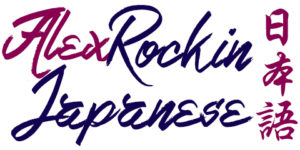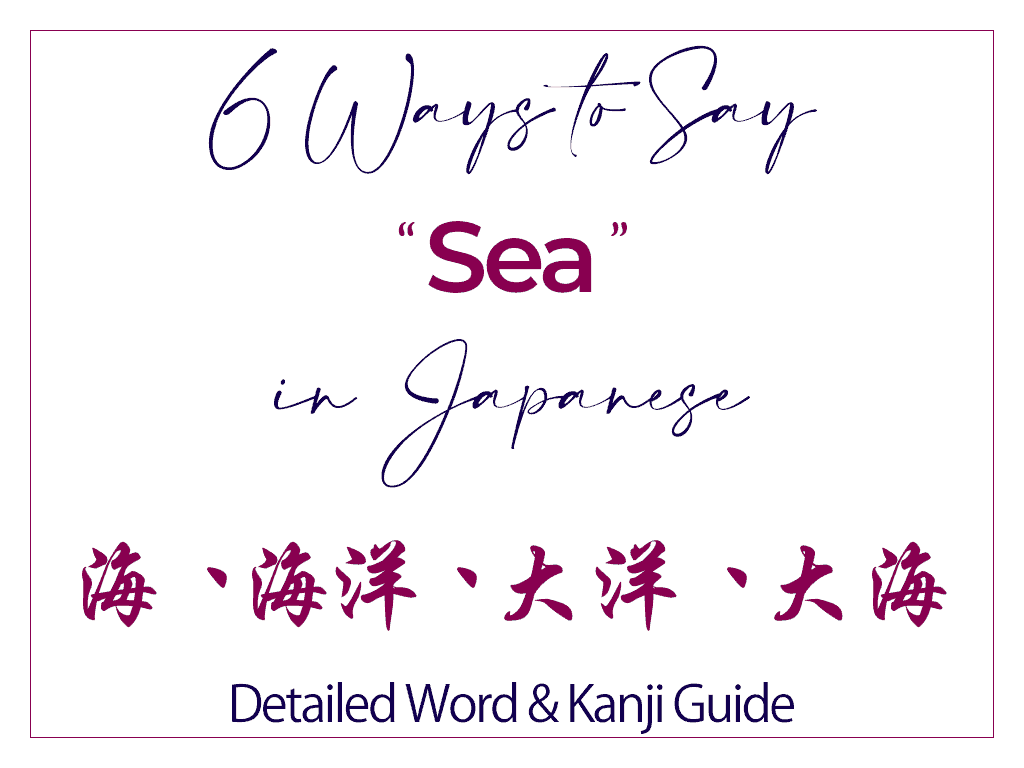If you want to know how to say “sea” or “ocean” in Japanese, you have come to the right place. In my blog post, I’m going to show you the 6 most commonly used Japanese words for “sea“, explain to you their differences, and tell you when you should use which word. Let’s start with the most common ones.
The most commonly used word to say “sea” or “ocean” in Japanese is umi (海). However, when referring to the five big oceans like the Pacific or the Atlantic Ocean the word taikai (大海) is more frequently used. In more scientific articles kaiyou (海洋) is the common word for “ocean”.
Below you can find the detailed definition and translation of the 6 most commonly used words to say “sea” or “ocean” in Japanese. After that, you can find a bunch of related words such as “sea dragon“, “sea monster“, “sea turtle“, and “sea lion“.
How to Say “Sea” and “Ocean” in Japanese
- umi – 海
- kaiyou – 海洋
- taiyou – 大洋
- taikai – 大海
- unabara – 海原
- ooshan – オーシャン
1. Umi – Common Way to Say “Sea” or “Ocean” in Japanese
Umi (海) is the most common word for “sea” or “ocean” in Japanese. All of my friends use this word when they tell me about the extremely beautiful sea in Okinawa, a day at the beach, or their last beach vacation. The kanji 海 itself stands for “sea” or “ocean“.
umi
海
sea
ocean
You can use the word umi (海) when referring to one of the five big oceans as well as any one of the smaller seas in casual conversations and daily situations.
2. Kaiyou – More Scientifc Term for “Ocean” in Japanese
The more scientific term for “ocean” is kaiyou (海洋). While the word isn’t that often used in everyday conversations, it is frequently used by marine experts and you might encounter it in ocean science articles. Generally speaking, the term is used to refer to a big ocean instead of a smaller sea.
kaiyou
海洋
ocean
3. Taiyou – Word Used to Refer to the 5 Big Oceans
Taiyou (大洋) also translates as “ocean” and is used to refer to the global ocean or the 5 big oceans: Atlantic, Pacific, Indian, Arctic, and the Antarctic, also known as the Southern Ocean. The word itself is written with the kanji for “big” 大 and the kanji for “ocean“, “(open) sea“, or “foreign” 洋.
taiyou
大洋
ocean
4. Taikai – Translates as “Ocean” or “Large Sea” in Japanese
Taikai (大海) is a less often used word that translates as “ocean” or “large sea“. Instead of “taikai” the kanji compound can also be read as “ooumi“. You can use the word whenever you want to emphasize the vast expanse of water or express things like the “mighty ocean“.
taikai
大海
ocean
large sea
5. Unabara – Means “Open Sea” or “Deep Sea”
The word unabara (海原) means “ocean”, “sea”, or “the deep”. So, in my opinion, it is best translated as “the open sea” or “deep sea“. It is also used in the word for “deep blue sea” which is “aounabara” (青海原). Ao and the kanji 青 both mean “blue”.
unabara
海原
open sea
deep seaaounabara
青海原
deep blue sea
6. Ooshan – English Loanword Meaning “Ocean”
There is also an English loanword in Japanese that means “ocean” which is ooshan (オーシャン). As usual, these borrowed words are mostly used in titles and names for places because they sound cooler to the Japanese than their original counterparts.
ooshan
オーシャン
ocean
Advanced Japanese Words Related to the “Ocean”
- kaiki – 海気
- senchou – 船長
- namako – ナマコ
- ashika – アシカ
- umigame – ウミガメ
- uni – うに
- umi no doragon – 海のドラゴン
- umi no kaibutsu – 海の怪物
Kaiki – “Ocean Breeze”
Kaiki (海気) is the Japanese word for “ocean breeze“, but it can also be translated as “sea air” or “sea breeze“. Sometimes it is also used to describe the ocean and its atmosphere in general. The word consists of 海, the kanji for the sea, and 気, the kanji for ambience, atmosphere, and mood.
kaiki
海気
ocean breeze
sea breeze
sea air
Senchou – “Sea Captain”
Senchou (船長) means “sea captain“, “ship’s captain“, or “skipper“, but the word can also be read as “funaosa“. The first kanji 船 means boat, the second kanji 長 means head, chief, or leader.
senchou
船長
sea captain
ship’s captain
skipper
Namako – “Sea Cucumber”
Namako (ナマコ) is the Japanese word for “sea cucumber“. It is usually written in katakana only, but it can also be written in kanji as 海鼠, however, in that case, it can also be read as “kaiso” instead of “namako”.
namako
ナマコ
sea cucumber
Ashika – “Sea Lion”
Ashika (アシカ) is the Japanese word for “sea lion” or “eared seal” and is especially used for the California sea lion. Since the kanji (海驢, 葦鹿) are quite complicated it is usually written in katakana only.
ashika
アシカ
sea lion
Umigame – “Sea Turtle”
The Japanese word for “sea turtle” is umigame (ウミガメ). It consists of the word umi (ウミ), which means “ocean” or “sea“, and the word kame (かめ), but pronounced as “game”, which translates as “turtle“.
umigame
ウミガメ
sea turtle
Uni – “Sea Urchin”
Uni (ウニ) is the Japanese word for “sea urchin“. It is usually written in katakana only, but if you want to write it in kanji you have two options. The first one is 海胆, the second one is 海栗. Although, for processed uni the following kanji compound is also commonly used 雲丹.
uni
ウニ
sea urchin
Umi no doragon – “Sea Dragon”
Umi no doragon (海のドラゴン) and umi no ryuu (海の龍) are the two phrases you can use to say “sea dragon” in Japanese. Doragon (ドラゴン) is an English loanword and usually used for western-style dragons, while ryuu (龍) is more commonly used for Chinese-style dragons.
umi no doragon
海のドラゴン
sea dragonumi no ryuu
海の龍
sea dragon
Umi no Kaibutsu – “Sea Monster”
Umi no kaibutsu (海の怪物) translates as “sea monster” or “monster of the sea“, but there are a bunch of other words for “monster” in Japanese, that you could use, too. For example, umi no monsutaa (海のモンスター) uses the English loanword for “monster”. However, “kaibutsu” seems to be most commonly used.
umi no kaibutsu
海の怪物
sea monsterumi no monsutaa
海のモンスター
sea monster


